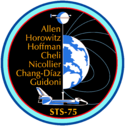STS-72
| STS-72 | |||||
 | |||||
| Uppdrag | 74 | ||||
|---|---|---|---|---|---|
| Rymdfärja | Endeavour (10)[1] | ||||
| NSSDC-ID | 1996-001A[2] | ||||
| Färdens tid | 8 dagar, 22 timmar, 1 minut, 47 sekunder | ||||
| Uppskjutning | |||||
| Startplats | Startplatta 39B vid Kennedy Space Center i Florida | ||||
| Start | 11 januari 1996, 4:41:00.072 EST | ||||
| Landning | |||||
| Landningsplats | KSC Runway 15 | ||||
| Landning | 20 januari 1996, 2:41:41 a.m. EST | ||||
| Omloppsbana | |||||
| Varv | 141 st[3] | ||||
| Apogeum | 470 km | ||||
| Perigeum | 185 km | ||||
| Banlutning | 28,45° | ||||
| Sträcka | 6 miljoner km | ||||
| Rymdpromenad | |||||
| Antal | 2 st | ||||
| Total tid | 13 timmar, 2 minuter | ||||
| Besättning | |||||
| Befälhavare | Brian Duffy (3) | ||||
| Pilot | Brent W. Jett (1) | ||||
| Uppdragsspecialister | Leroy Chiao (2) Daniel T. Barry (1) Winston E. Scott (1) Koichi Wakata (1) Japan | ||||
 | |||||
| Kronologi Rymdfärjeprogrammet | |||||
| |||||
STS-72 var ett uppdrag med NASAs rymdfärja Endeavour. Den sköts upp från Pad 39B vid Kennedy Space Center i Florida den 11 januari 1996. Efter nästan nio dagar i omloppsbana runt jorden återinträdde rymdfärjan i jordens atmosfär och landade vid Kennedy Space Center.
Besättning
- Brian Duffy (3), befälhavare
- Brent W. Jett (1), pilot
- Leroy Chiao (2), uppdragsspecialist
- Daniel T. Barry (1), uppdragsspecialist
- Winston E. Scott (1), uppdragsspecialist
- Koichi Wakata (1), uppdragsspecialist - JAXA/Japan
Siffran inom parentes anger antal rymdfärder till och med denna.
Se även
Referenser
- ^ NASA Space Shuttle Launch Archive Arkiverad 20 december 2016 hämtat från the Wayback Machine., läst 28 juli 2016.
- ^ ”NASA Space Science Data Coordinated Archive” (på engelska). NASA. https://nssdc.gsfc.nasa.gov/nmc/spacecraft/display.action?id=1996-001A. Läst 20 mars 2020.
- ^ Manned Astronautics - Figures & Facts Arkiverad 4 mars 2016 hämtat från the Wayback Machine., läst 28 juli 2016.
Externa länkar
 Wikimedia Commons har media som rör STS-72.
Wikimedia Commons har media som rör STS-72.
| ||||||||
| ||||||||||||||||||||||||||||||||
Media som används på denna webbplats
Författare/Upphovsman: Pascal (Flickr user: pasukaru76), Licens: CC0
Vostok spacecraft replica at the Technik Museum Speyer, Germany.
STS-74 Mission Insignia
- The STS-74 crew patch depicts the orbiter Atlantis docked to the Russian Space Station Mir. The central focus is on the Russian-built docking module, drawn with shading to accentuate its pivotal importance to both STS-74 and the NASA-Mir Program. The rainbow across the horizon represents the Earth's atmosphere, the thin membrane protecting all nations, while the three flags across the bottom show those nations participating in STS-74: Russia, Canada, and the United States. The sunrise is symbolic of the dawn of a new era in NASA space flight , that of International Space Station construction.
Six astronauts composed the crew for the STS-72 mission that launched aboard the Space Shuttle Endeavour on January 11, 1996. Astronauts Brian Duffy (right front) and Brent W. Jett (left front) are mission commander and pilot, respectively. Mission specialists (back row, left to right) are Winston E. Scott, Leroy Chiao, Koichi Wakata, and Daniel T. Barry. Wakata is an international mission specialist representing Japan's National Space Development Agency (NASDA) based at the Johnson Space Center (JSC). Mission objectives included the retrieval of the Japanese Space Flyer Unit (SFU), and the deployment of the Office of Aeronautics and Space Technology-Flyer (OAST-Flyer).
STS-72 Mission Insignia
STS-75 Mission Insignia






